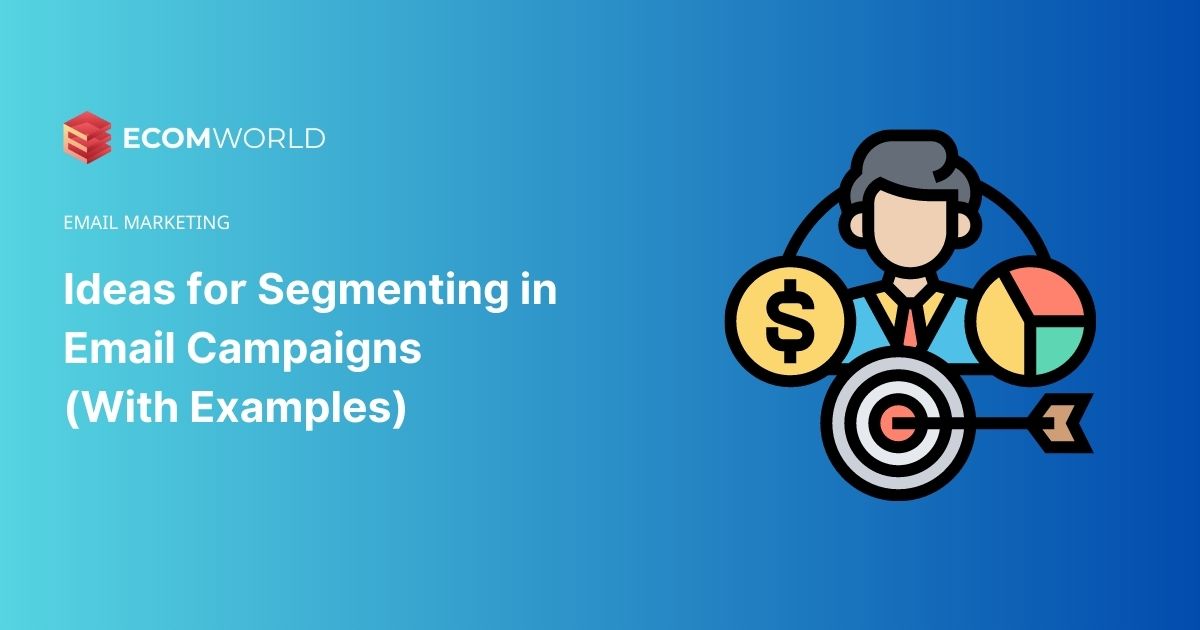Table of Contents
Despite the ongoing significance of face-to-face interactions and phone calls in the business world, email has rapidly gained prominence. It has become the primary mode of communication for many businesses, making it crucial for senders to ensure that their recipients not only open but also read their emails. An effective way to achieve this is through email marketing segmentation, which enables the delivery of targeted information to the appropriate individuals. Below are tips and examples for your email segmentation to work effectively and approach the proper recipients at the right time.
What Is Email Segmentation?
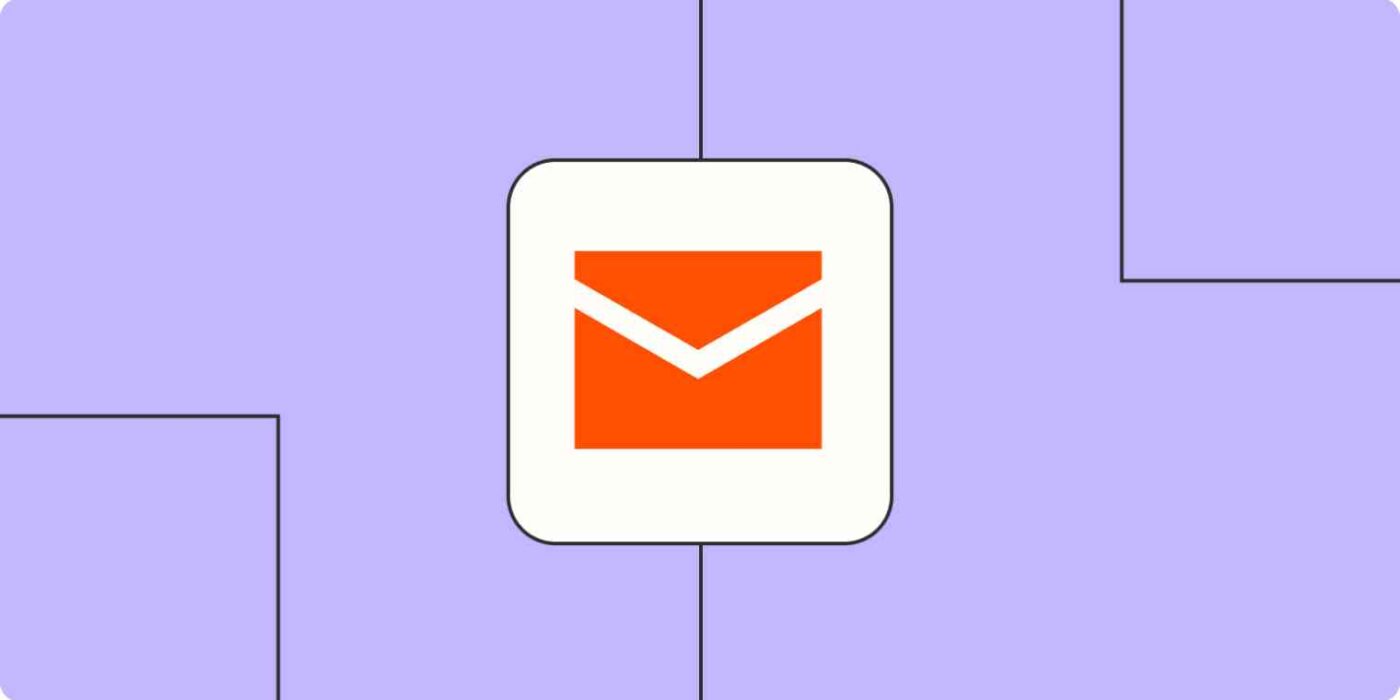
Basically, email segmentation, also known as list segmentation, involves dividing your email recipients into smaller, focused groups and delivering them the most appropriate information. These groups are typically formed based on behavioral or demographic data, such as the recipient’s location, previous purchases, or specific actions they have taken on your website.
You have the flexibility to create segments of various sizes, ranging from larger ones, such as individuals who purchased a specific product through your Instagram shop, to smaller ones, like Arizona residents who recently subscribed to your newsletter. However, as the segments become smaller, it is important to make your content more focused and personalized. This approach increases the likelihood of resonating with the recipients and engaging them effectively.
The Importance of Email Segmentation
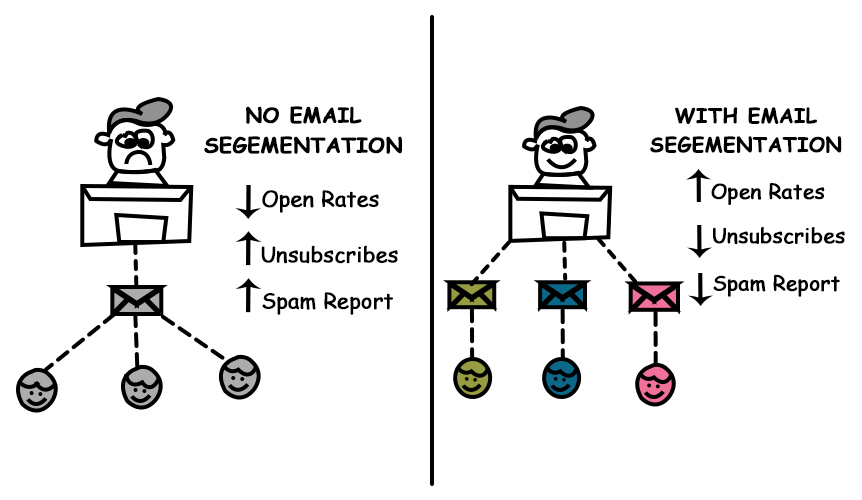
According to research conducted by Radicati Group Inc, over 246 billion emails are exchanged daily, out of which 128 billion are intended for business-related matters. Given the sheer volume of emails reaching recipients’ inboxes, the practice of email segmentation becomes crucial as it can determine whether an email is opened or deleted.
Apart from enabling the delivery of personalized and pertinent content to specific groups of subscribers, employing list segmentation for email campaigns offers several additional advantages for businesses, including:
- Enhances open rates: How frequently do you simply archive an email without even opening it, solely based on the subject line? By providing more relevant content and subject lines, you increase the chances of your emails being noticed and read.
- Boosts click-through rates: Once recipients are engaged with your email, they are more likely to interact with compelling calls to action, such as exploring the featured sale or learning more about your new service.
- Improves conversion rates: As individuals progress closer to a desired goal, their motivation and efforts tend to intensify. This phenomenon, known as the gradient goal effect in consumer psychology, implies that once visitors reach your website, they are more inclined to make a purchase or register for the webinar you’re promoting.
- Reduces unsubscribers: Your aim is to expand your subscriber base rather than diminish it. Sending excessive irrelevant emails can lead people to disengage from your offerings altogether, seeking to reduce noise in their inboxes.
- Avoids spam filters: Even if individuals don’t personally unsubscribe after receiving too many irrelevant emails, their email providers may classify your messages as spam. Segmented lists help enhance deliverability and avoid being flagged as unwanted content.
12 Segmentation Ideas In Email Campaigns
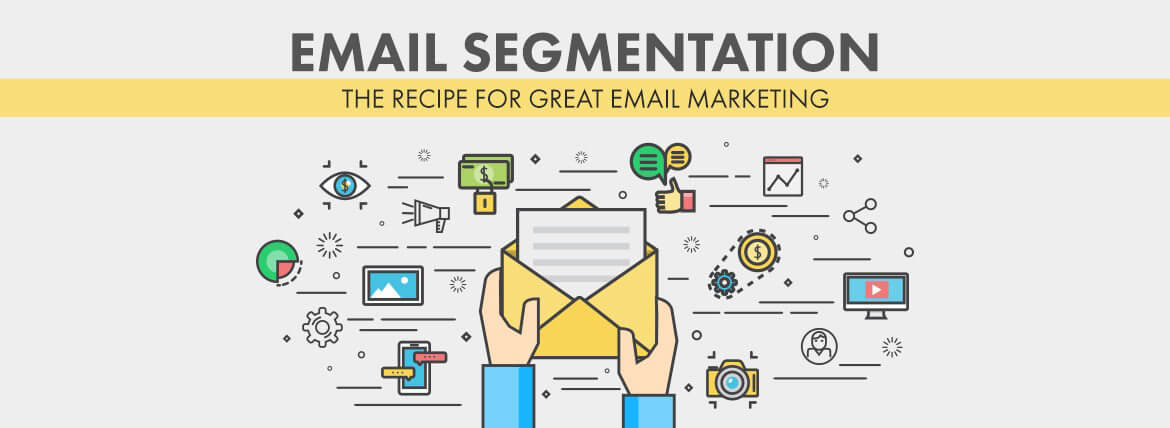
Engage new subscribers with onboarding emails
Establish an email segment specifically for individuals who have recently signed up within the past 30 days, and initiate a series of onboarding emails known as a drip campaign. Similar to the onboarding email example from Squarespace, these emails motivate users to explore specific features or tutorials. By providing them with frequent calls to action, you can keep them engaged and interested while their attention is still fresh.
Don’t hesitate to explore and unleash your creativity when it comes to segmenting during the onboarding campaign. For instance, if certain users show a preference for tutorials, you can create a separate segment for them and continue providing relevant knowledge. Alternatively, if you notice a subgroup of new users consistently visiting your “upgrade” page, it might be worthwhile to create a segment specifically for them and send targeted offers or promotions. Feel empowered to experiment and tailor your segments based on user behavior and preferences.
Reward loyal customers with celebratory offers and exclusive deals
Implementing a segment dedicated to loyal customers is a highly effective strategy, especially for eCommerce websites. You may have heard the saying that acquiring new customers is more costly than retaining existing ones. Additionally, loyal customers will appreciate the sense of belonging to an exclusive club.
Consider creating special offers for your customers who have been with you since the beginning, particularly if your company is celebrating a significant anniversary or milestone. Show your appreciation to these year-one customers by providing them with exclusive coupon codes, acknowledging their role in the early growth of your business.
Alternatively, you can reward your most engaged or highest-spending customers, depending on what indicators of engagement or spending are relevant for your business. Grant them early access to new offerings before other segments of your customer base are informed. For instance, Sephora offers early access to new products for customers in its highest rewards tier. While this example is not email-specific, you can certainly adapt this incentive and reward system to enhance your email marketing campaign.
B2B vs. B2C: keep them separated
Here’s a segmentation strategy that offers a two-for-one approach: establish separate segments for your B2B (business-to-business) and B2C (business-to-consumer) customers. If you have customers who purchase in bulk as part of their business operations, they may not be interested in promotions such as a $5 discount sale or an influencer-hosted Instagram Live event. However, they would likely appreciate receiving information about business-exclusive tutorials or webinars.
Create targeted email campaigns for each audience whenever it is relevant to do so. However, it’s important to note that not every single email may require this level of segmentation. The beauty of email segmentation lies in the ability to maintain multiple lists simultaneously and utilize the most appropriate segment for each content or campaign.
Lean into readers with high open rates
Customers who consistently open the majority of your emails do so for a reason. They enjoy your content, regularly shop on your site, and have a genuine interest in staying updated with your news. Consider creating a segment specifically for these engaged customers who open at least 50% of your emails. Treat them similarly to loyal or frequent buyers by providing them with fresh updates, promotions, and engaging content that they will truly appreciate. This segment is also an ideal target for market research surveys, as they are the most likely to open and respond to your requests.
Additionally, you can further segment your customer base based on their preferences for specific content types. For instance, some customers may open 100% of your promotional emails, while others may show more interest in reading about brand-new product launches. By creating segments based on content preferences, you can continue delivering precisely what these customers desire, or you can experiment with alternative content to see what captures their attention.
Reel inactive customers back in
Conversely, if you have a segment of your email list that consistently shows low email open rates, it’s important not to take it personally. Instead, consider creating a segment specifically for those who open less than 10% of your emails and explore different approaches to engage them. You can experiment with two strategies: sending more frequent emails in an attempt to capture their interest and involvement, or reducing the frequency of emails to avoid coming across as bothersome. However, keep in mind that this segment may be temporary as you gather data and insights from these experiments. It’s crucial to strike a balance and avoid further alienating your customers.
Show your regular buyers you value them
In a similar vein to long-term buyers, there are customers who make regular purchases from you, and there is no specific timeframe for this segment. This group is ideal for receiving notifications about new products, exclusive deals, and invitations to special events, particularly if the offerings align with their actual purchasing patterns.
Leverage the data on purchase history to fuel your creativity when segmenting your customers. For instance, if you notice that the same set of seven customers consistently repurchases chocolate from your shop on the first of every month, you can specifically target them with updates on new chocolate varieties that you have added to your store.
Gently remind those who didn’t buy
Have you ever encountered individuals who exhibit high click-through rates but don’t actually make a purchase? It can certainly be frustrating, but there is a segmentation strategy to address this. While it might be excessive to remind someone about an abandoned cart after just five minutes, customers who recently browsed your website without making a purchase may benefit from a gentle nudge. Consider sending them subtle reminders or incentives if they clicked through an email to your site but haven’t made a purchase within the past five days.
There can be countless reasons why people decide not to make a purchase. Perhaps they needed to wait until their payday and then forgot, or the specific option that aligned with their preferences was temporarily out of stock. Following up with these customers presents an excellent opportunity to regain their attention and position yourself back at the top of their inboxes and in their minds.
Inform would-be buyers about restocks
Occasionally, a customer may abandon their purchase because the desired item is out of stock. What customers may not realize is that by clicking the “Email me when back in stock” button on your website, they automatically join an email segment. Through automation, they will receive a notification when the item is restocked, eliminating the need for manual input from you. However, in the meantime, you can nurture this segment by providing stock updates (“We’re eagerly anticipating its return, too! It won’t be much longer.”) or even offer a discount code as an apology if you’re feeling generous.
Nurture leads in the sales funnel
The type of emails individuals receive should vary depending on their position within the lead generation funnel. To illustrate, a “warm leads” segment can be nurtured by sharing product benefits, conducting “getting to know us” campaigns, and providing gentle reminders to schedule a call with your sales team. On the other hand, established customers may be categorized into a different segment, such as regular buyers or inactive readers, warranting tailored emails that cater to their specific needs and interests.
Respond to changes in behaviors
If you had a customer who used to make regular purchases but suddenly stopped, it’s worth investigating why. You can experiment with re-engagement strategies by creating a segment list specifically for customers who had a previous purchase history but haven’t made a purchase in the last six months. Consider offering them larger discounts than you would to other customers or even conducting a survey to gather insights for your own research.
It’s important to remember that life can get hectic, and sometimes people just need a gentle nudge to rekindle their interest. For instance, Duolingo employs a clever tactic by sending a sad owl to users who haven’t practiced for a week or so, using its adorable puppy-owl eyes to entice users back. Similarly, finding creative ways to grab the attention of dormant customers can be highly effective.
Use roles and responsibilities as clues
In the realm of B2B sales, it is possible to create segments based on distinct roles, departments, or purchasing authority. For instance, an inventory update would primarily be relevant to the procurement team, whereas data security policies might be more appropriate for C-level decision-makers or IT teams. The content you send to these segments will vary depending on your specific offerings. Additionally, this segmentation strategy enables you to customize your content to suit different roles. Even if the subject matter of your email remains the same, you would likely craft your copy differently for each role, ensuring greater relevance and resonance.
Tap into your customer personas
By categorizing people into different personas, you can gain insights into their distinct personalities, values, desires, and needs. Employing specific segments tailored to these characteristics is an effective strategy that yields continuous benefits.
For instance, if you’re launching a new line of dog treats, it makes sense to create a segment specifically for dog owners. Similarly, if your new app is only available on iOS, segmenting out iPhone users is a logical approach. When the back-to-school season is approaching, targeting parents with a dedicated segment can be highly relevant.
Don’t hesitate to conduct surveys among your readers to determine which segments are most pertinent. This approach emphasizes mutual value exchange: you gain a deeper understanding of your customers, enabling you to refine your marketing strategies, while they receive greater value by receiving content that genuinely interests them. For example, receiving an email promoting merchandise for rival teams would prompt me to delete it instantly, even though I know in my heart that my team will likely lose to most of them this year.
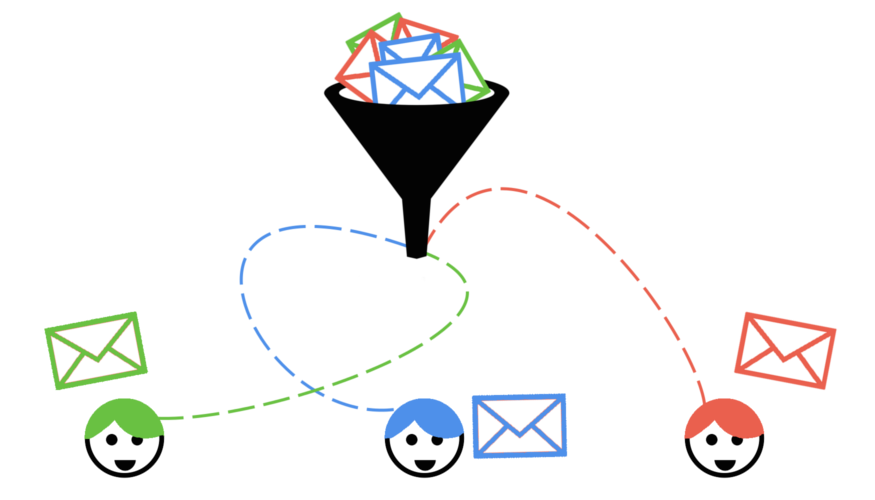
In conclusion, segmenting your email campaigns is a powerful strategy that can elevate your marketing efforts to new heights. By dividing your audience into distinct segments based on demographics, behavior, engagement, and other relevant factors, you can deliver personalized and targeted content that resonates with your recipients.
Segmenting allows you to tailor your messages to specific customer groups, ensuring that they receive the most relevant information and offers. This not only increases the chances of your emails being opened and clicked on, but also fosters a deeper connection with your audience. By understanding their unique needs, preferences, and interests, you can deliver value-driven content that keeps them engaged and eager to interact with your brand.
Furthermore, segmentation enables you to optimize your email campaigns by analyzing the performance of different segments. You can gather valuable insights into customer behavior, purchase patterns, and preferences, allowing you to refine your strategies and improve overall campaign effectiveness.
Remember to be creative and experiment with various segmentation approaches. Whether it’s segmenting based on demographics, purchase history, engagement levels, or specific interests, the key is to continuously refine your segments and adapt your content accordingly.
By implementing effective segmentation strategies, you can unlock the full potential of your email campaigns, increasing open rates, click-through rates, and conversion rates, and ultimately driving business growth. Embrace the power of segmentation and watch your email marketing efforts thrive.

